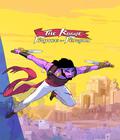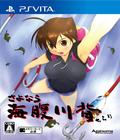The popularity of consumer Internet in the late 1990s made gamers aware of the presence of titles that weren't released in their own region. Even if you weren't willing to modify your system, buy one specifically for that region, or learn the language, you learned about some of the titles and hoped that you'd get a chance to play them someday. One such title is Umihara Kawase, a platformer from the Super Famicom era whose entire series stayed in Japan but gained a small worldwide following thanks to the popularity of the Japanese TV show, "Game Center CX." For the first time, the series hits North America with Sayonara UmiharaKawase+, the last entry in the series.
In an unusual move for a game in the modern era, Sayonara UmiharaKawase+ hasno story in the game or the instruction book. The most you're told is that you're a sushi chef who has been transported to an alternate world where fish have legs and walk on land while everyday objects, like pencils, are larger than yourself. With nothing but a fishing rod at your disposal, you look for a way out of this strange world.
The gameplay basics are standard platformer fare. You can jump on platforms to avoid spikes and deep bodies of water. Enemies come in all types, and while some merely stun you with a hit and knock you back a few steps, most kill you with one hit. You can climb ladders and floor edges, but you can't run, limiting your versatility even though your standard walking speed is good enough for most situations.
Your fishing pole is the only tool in your arsenal, and while that may not seem like much, it's very versatile. You can fire a line to stun enemies, but its primary function is as a grappling hook. You'll attach it to ceilings to swing across large gaps, attach it to a wall to pull yourself toward it, and attach it to enemies so you can reel them toward you (if they aren't too heavy). You can also attach it to the floor to lower yourself down ledges, and you can adjust the line length for better control.
Since the fishing pole is so versatile, the game's challenge comes from the level design and the physics system. Unlike most platformers, most of the levels are vertical, so while you'll cross a few obstacles, you'll spend most of your time moving up and down the level to locate the exit. The physics adhere to realism — to a point. Longer line length means the ability to swing at longer arcs, and you can use momentum to propel yourself, but that's the extent of it. You can also pull off some ridiculous swings, and skilled players can pull off some amazing moves, but don't expect full control, such as easily coming to a complete standstill.
What's surprising is how difficult the game becomes in such a short amount of time. Beyond the first two levels, the difficulty rises very steeply. Though there are a few opportunities to save yourself from a bad cast, almost every jump requires great accuracy and mastery of the game's physics. The insistence on using polygons instead of sprites also gives you the feeling that the platforming is a little less accurate than you might like, even though the controls are rather tight. Every stage is a long lesson in trial and error, and the difficulty is compounded by the fact that stages are short enough to not have checkpoints. You'll be forced back to the beginning after every mistake, and while you have unlimited lives and no timer, the slight loading times you endure after every death make you wish that a quick restart button were available before you conquer a level instead of afterward.
If the high level of difficulty doesn't scare you away, then you'll be happy with what Sayonara UmiharaKawase+ offers. There are over 60 stages, with most of them hiding a backpack or two that can be obtained. Doing so opens up things like artwork and songs for the music player, but you can also unlock new characters who have little bonuses, like creating checkpoints in a stage or slowing down time for more accurate controls. Several stages also have alternate pathways, which are essential since you aren't able to go through the stages in sequential order. Part of the reason is because there are five bosses, and each one acts as a sort of end game boss. Since finding one of these bosses only means you've explored one-fifth of the content, you'll need multiple playthroughs to uncover every stage and beat the game.
In addition to the main quest, the title provides a few extras. Obtaining one of the endings gives you the chance to play in Survival mode, where you try to get as far as you can with only three lives at your disposal. You can still obtain backpacks, but they'll count as extra lives instead of as a means to unlock bonus content. Leaderboards are also present, so you can compete with others for the best completion time per stage. The most exciting extra is unlocked from the beginning, and that's the inclusion of the original Super Famicom game. It hasn't aged a bit in terms of providing players with a significant challenge. This is arguably a much harder game than the latest one because you start off with a finite amount of lives and each stage has a timer. There's no save mechanic either, so losing all of those lives means restarting the game from the very beginning. This is a big extra that the 3DS version didn't get, making this a more definitive version of the game.
For a non-indie game made for the Vita, the graphics look out of place, and one could even mistake it for being a very clean PSP game. The characters move fluidly enough, though some animation gaps are present. The environments are comprised of very colorful blocks that don't have much definition, sometimes causing confusion between the background and foreground elements. There's not much eye candy in terms of particle effects and lighting tricks, but the game moves along at a steady frame rate.
The audio is good but rather sparse. The music is good but a little odd since it goes for a cheerful vibe all the time. Even during boss fights, where players expect something a little more up-tempo, the music is relaxing and contrasts the action. There also aren't that many tracks, and though you won't tire of the material, you will notice several of them repeating often. Don't expect much else in the sound department. The effects are nice but are only heard if you're using headphones, and voices are completely absent.
Sayonara UmiharaKawase+ is a fun but ultimately divisive game. The level of difficulty is certainly up there, and it escalates quickly, so you'll hit roadblocks very early. Add the one-hit kills, and many players may give up on this quickly. If you're persistent, there are plenty of tricks that can be pulled off once you master the controls, and lots of levels to make use of that. The extra modes are nice, but the inclusion of the original game really makes this proposition sweeter than the 3DS incarnation. As long as you're up for a tough-as-nails platformer, give Sayonara UmiharaKawase+ a shot.
Score: 7.0/10
More articles about Sayonara UmiharaKawase +











 Sayonara UmiharaKawase + is a Rubbering Action physics-based puzzle platform game.
Sayonara UmiharaKawase + is a Rubbering Action physics-based puzzle platform game.





